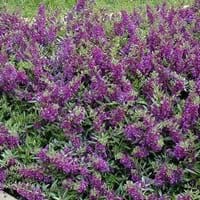Life Span
Perennial
Perennial
Type
Flowering Plants
Tender Perennial
Origin
Italy, Southern Europe, western Balkans
Mexico, Caribbean
Types
not available
Not available
Habitat
Islands, Not Available
Cultivated Beds, gardens
USDA Hardiness Zone
7-10
9-10
Sunset Zone
21,22
H1, H2, 1a, 1b, 2a, 2b, 3a, 3b, 4, 5, 6, 7, 8, 9, 10, 11, 12, 13, 14, 15, 16, 17, 18, 19, 20, 21, 22, 23, 24
Habit
Upright/Erect
Upright/Erect
Flower Color
Lavender, Light Blue, White
Purple, Lavender
Flower Color Modifier
Bicolor
Not Available
Fruit Color
Non Fruiting Plant
Not Available
Leaf Color in Spring
Green, Light Green
Green
Leaf Color in Summer
Green, Light Green
Green
Leaf Color in Fall
Green, Light Green
Green
Leaf Color in Winter
Light Green
Green
Leaf Shape
Compound
Long linear and narrow
Plant Season
Summer, Fall
Spring, Summer, Fall
Sunlight
Full Sun, Partial Sun
Full Sun, Partial Sun
Growth Rate
Medium
Very Fast
Type of Soil
Loam
Clay, Loam, Sand
The pH of Soil
Acidic, Neutral
Acidic, Neutral, Alkaline
Soil Drainage
Average
Well drained
Bloom Time
Early Summer, Summer, Late Summer
Indeterminate
Tolerances
Heat Tolerance
Drought, Heat And Humidity
Where to Plant?
Ground, Pot
Container, Ground, Pot
How to Plant?
From bulbs, Seedlings, Stem Planting
Root Division, Seedlings, Tip cutting
Plant Maintenance
Low
Low
Watering Requirements
Average Water Needs, Do Not over Water, Never Over-water, Requires regular watering
Needs 2-3 times watering per week, Water daily during growing season, Water in morning to avoid prompting diseases, Water slowly, and allow to dry completely between soakings
In Summer
Lots of watering
Lots of watering
In Spring
Moderate
Moderate
In Winter
Average Water
Average Water
Soil pH
Acidic, Neutral
Acidic, Neutral, Alkaline
Soil Type
Loam
Clay, Loam, Sand
Soil Drainage Capacity
Average
Well drained
Sun Exposure
Full Sun, Partial Sun
Full Sun, Partial Sun
Pruning
Remove damaged leaves, Remove dead branches, Remove dead leaves, Remove dead or diseased plant parts
Cut or pinch the stems, Dispose of diseased portions, Remove damaged leaves, Remove dead branches, Remove dead leaves, Remove dead or diseased plant parts
Fertilizers
fertilize every 2-3 weeks while growing, fertilize in growing season
All-Purpose Liquid Fertilizer, Apply 10-5-10 amounts
Pests and Diseases
fungus
Aphids, Powdery mildew, Red blotch
Plant Tolerance
Drought, Heat Tolerance
Drought, Heat And Humidity
Flower Petal Number
Single
Single
Showy Foliage
Not Available
No
Foliage Texture
Not Available
Medium
Foliage Sheen
Not Available
Matte
Attracts
Birds, Insects
Butterflies
Allergy
Toxic
Not Available
Aesthetic Uses
Beautification, Landscape Designing, Showy Purposes
Beautification, Cottage Garden, Showy Purposes
Beauty Benefits
Not Available
Not Available
Environmental Uses
Air purification
Not Available
Medicinal Uses
Asthma, Cough, Unknown
anti-inflammatory
Part of Plant Used
Flowers, Leaves
Flowers
Other Uses
Decoration Purposes, Showy Purposes, Used as Ornamental plant
Used as Ornamental plant, Used for bedding in gardens
Used As Indoor Plant
Yes
Yes
Used As Outdoor Plant
Yes
Yes
Garden Design
Mixed Border, Wildflower
Bedding Plant, Container, Mixed Border, Tropical
Botanical Name
CAMPANULA pyramidalis
ANGELONIA angustifolia
Common Name
Chimney Bellflower
Angelonia, Narrowleaf Angelon, Summer Snapdragon
In Hindi
Chimney Bellflower
Angelonia
In German
Schornstein Glockenblume
Angelonia
In French
cheminée Bellflower
Angelonia
In Spanish
Chimenea Bellflower
Angelonia
In Greek
καμινάδα καμπανούλα
Angelonia
In Portuguese
chaminé Bellflower
Angelonia
In Polish
komin Bellflower
Angelonia
In Latin
caminorum purgatores Bellflower
Angelonia
Phylum
Tracheophyta
Magnoliophyta
Class
Magnoliopsida
Magnoliopsida
Order
Asterales
Scrophulariales
Family
Campanulaceae
Scrophulariaceae
Genus
Campanula
Angelonia
Clade
Angiosperms, Asterids, Eudicots
Angiosperms, Asterids, Eudicots
Tribe
Not Available
Not Available
Subfamily
Not Available
Not Available
Number of Species
Not Available
Season and Care of Chimney Bellflower and Angelonia
Season and care of Chimney Bellflower and Angelonia is important to know. While considering everything about Chimney Bellflower and Angelonia Care, growing season is an essential factor. Chimney Bellflower season is Summer and Fall and Angelonia season is Summer and Fall. The type of soil for Chimney Bellflower is Loam and for Angelonia is Clay, Loam, Sand while the PH of soil for Chimney Bellflower is Acidic, Neutral and for Angelonia is Acidic, Neutral, Alkaline.
Chimney Bellflower and Angelonia Physical Information
Chimney Bellflower and Angelonia physical information is very important for comparison. Chimney Bellflower height is 120.00 cm and width 45.70 cm whereas Angelonia height is 30.50 cm and width 30.50 cm. The color specification of Chimney Bellflower and Angelonia are as follows:
Chimney Bellflower flower color: Lavender, Light Blue and White
Chimney Bellflower leaf color: Green and Light Green
Angelonia flower color: Purple and Lavender
- Angelonia leaf color: Green
Care of Chimney Bellflower and Angelonia
Care of Chimney Bellflower and Angelonia include pruning, fertilizers, watering etc. Chimney Bellflower pruning is done Remove damaged leaves, Remove dead branches, Remove dead leaves and Remove dead or diseased plant parts and Angelonia pruning is done Cut or pinch the stems, Dispose of diseased portions, Remove damaged leaves, Remove dead branches, Remove dead leaves and Remove dead or diseased plant parts. In summer Chimney Bellflower needs Lots of watering and in winter, it needs Average Water. Whereas, in summer Angelonia needs Lots of watering and in winter, it needs Average Water.





